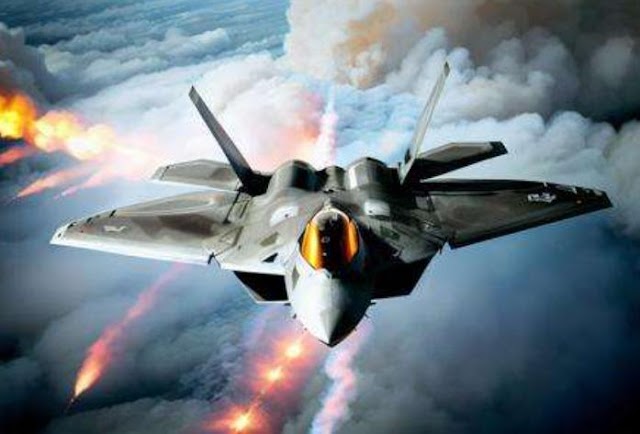The Lockheed F-117 Nighthawk: Pioneering Stealth Technology
In the realm of military aviation, the Lockheed F-117 Nighthawk holds a unique position as the first operational aircraft designed with stealth technology. This article delves into the fascinating journey of the F-117, from its development to combat engagements and eventual retirement.
.jpg) |
| F-117 Nighthawk |
Development of the F-117: Countering Soviet Threats
The genesis of the F-117 can be traced back to the 1970s when the threat posed by sophisticated Soviet surface-to-air missiles (SAMs) prompted the initiation of its development. The Defense Advanced Research Projects Agency (DARPA) played a pivotal role by contracting Lockheed to produce the Have Blue technology demonstrator.
Role: Stealth attack aircraft
National origin: United States
Manufacturer: Lockheed Corporation
The first flight: June 18, 1981; 42 years ago
Status: Used as training aircraft as of 2023
Primary users: United States Air Force
Have Blue Technology Demonstrator: Validating Stealth Concept
The Have Blue technology demonstrator, initiated in 1976, provided crucial test data that validated the concept of stealth technology. This marked a turning point, leading to the official decision on November 1, 1978, to proceed with the F-117 development program.
Maiden Flight and Initial Operating Capability
The first of the five F-117 prototypes took to the skies in 1981 at Groom Lake, Nevada. Subsequent milestones included the delivery of the first production F-117 in 1982 and the achievement of initial operating capability in October 1983. These events marked the beginning of a new era in stealth aviation.
Design Features: Faceted Shape and Infrared Signature
The distinctive faceted shape of the F-117, composed of two-dimensional flat surfaces, played a crucial role in achieving its relatively low radar cross-section of about 0.001 m2. To minimize the infrared signature, the aircraft featured a non-circular tail pipe, mixing hot exhaust with cool ambient air and deliberately lacking afterburners.
Stealth Fighter or Attack Aircraft: Clarifying the Role
Despite commonly being referred to as the "Stealth Fighter," the F-117 was strictly an attack aircraft. Equipped with integrated digital navigation and attack systems, it excelled in precision strikes. However, its performance in air combat maneuvering was eclipsed by contemporary fighters.
Digital Navigation and Attack Systems
The F-117 boasted sophisticated navigation and attack systems integrated into a digital avionics suite. GPS and high-accuracy inertial navigation were the primary means of navigation, while an automated planning system streamlined attack missions, including weapons release.
Challenges: Aerodynamic Instability and Constant Flight Corrections
A unique aspect of the F-117 was its aerodynamic instability in all three principal axes, necessitating constant flight corrections through a fly-by-wire (FBW) flight system. This challenging characteristic was overcome by cutting-edge technology, ensuring controlled flight.
Secrecy Surrounding the F-117
For years following its entry into service, the F-117 remained a black project, its existence denied by USAF officials. The shroud of secrecy was lifted on November 10, 1988, revealing the previously concealed capabilities of this groundbreaking aircraft.
Gulf War and Other Combat Engagements
The F-117 earned widespread recognition during the Gulf War of 1991, flying over 1,300 sorties and scoring direct hits on 1,600 high-value targets in Iraq. It also participated in conflicts such as the United States invasion of Panama in 1989, the conflict in Yugoslavia, Operation Enduring Freedom in 2001, and Operation Iraqi Freedom in 2003.
Retirement and Fleet Status
In April 2008, the USAF officially retired the F-117, primarily due to the introduction of the F-22 Raptor. However, a portion of the fleet has been maintained in airworthy condition, with F-117s observed flying since 2009, adding an air of mystery to their retirement.
Influences from Other Aircraft: Cost-Effective Solutions
To reduce development costs, the F-117 incorporated avionics, fly-by-wire systems, and parts derived from various existing aircraft, including the General Dynamics F-16 Fighting Falcon, Boeing B-52 Stratofortress, McDonnell Douglas F/A-18 Hornet, and McDonnell Douglas F-15E Strike Eagle.
Cockpit Features and Specifications
The single-seat F-117, powered by two non-afterburning General Electric F404 turbofan engines, featured a spacious cockpit with ergonomic displays and controls. However, a large blind spot to the rear hindered the field of view.
Radar Cross-Section (RCS) and Limitations
The F-117's radar cross-section (RCS) of about 0.001 m2 resulted from 1970s-era computer technology. Despite limitations such as lower engine thrust, a low wing aspect ratio, and a high sweep angle, the F-117 excelled in maintaining a minimal RCS.
Multistatic Radar Systems: Detecting Stealth Aircraft
While traditional radars faced challenges in detecting stealth aircraft, multi-static radar systems emerged as effective alternatives. The F-117's first-generation stealth technology reflected energy away from the transmitter's line of sight, increasing the RCS in other directions, and allowing passive radars to monitor it more effectively.
Conclusion
The Lockheed F-117 Nighthawk's legacy as a pioneer in stealth technology and its significant contributions to modern military aviation are indisputable. From countering Soviet threats to participating in pivotal conflicts, the F-117 left an indelible mark on the history of aerial warfare.
Frequently Asked Questions (FAQs)
1. Q: When was the F-117 publicly acknowledged for the first time?
- A: The F-117 was publicly acknowledged on November 10, 1988.
2. Q: What was the primary reason for the retirement of the F-117?
- A: The USAF retired the F-117 in April 2008, primarily due to the introduction of the F-22 Raptor.
3. Q: How many F-117s were delivered in total?
- A: A total of 59 production F-117s were delivered, with the last one on July 3, 1990.
4. Q: What role did the F-117 play in the Gulf War?
- A: The F-117 played a crucial role in the Gulf War of 1991, flying approximately 1,300
National origin: United States
Manufacturer: Lockheed Corporation
The first flight: June 18, 1981; 42 years ago
Status: Used as training aircraft as of 2023
Primary users: United States Air Force
Have Blue Technology Demonstrator: Validating Stealth Concept
The Have Blue technology demonstrator, initiated in 1976, provided crucial test data that validated the concept of stealth technology. This marked a turning point, leading to the official decision on November 1, 1978, to proceed with the F-117 development program.
Maiden Flight and Initial Operating Capability
The first of the five F-117 prototypes took to the skies in 1981 at Groom Lake, Nevada. Subsequent milestones included the delivery of the first production F-117 in 1982 and the achievement of initial operating capability in October 1983. These events marked the beginning of a new era in stealth aviation.
Design Features: Faceted Shape and Infrared Signature
The distinctive faceted shape of the F-117, composed of two-dimensional flat surfaces, played a crucial role in achieving its relatively low radar cross-section of about 0.001 m2. To minimize the infrared signature, the aircraft featured a non-circular tail pipe, mixing hot exhaust with cool ambient air and deliberately lacking afterburners.
Stealth Fighter or Attack Aircraft: Clarifying the Role
Despite commonly being referred to as the "Stealth Fighter," the F-117 was strictly an attack aircraft. Equipped with integrated digital navigation and attack systems, it excelled in precision strikes. However, its performance in air combat maneuvering was eclipsed by contemporary fighters.
Digital Navigation and Attack Systems
The F-117 boasted sophisticated navigation and attack systems integrated into a digital avionics suite. GPS and high-accuracy inertial navigation were the primary means of navigation, while an automated planning system streamlined attack missions, including weapons release.
Challenges: Aerodynamic Instability and Constant Flight Corrections
A unique aspect of the F-117 was its aerodynamic instability in all three principal axes, necessitating constant flight corrections through a fly-by-wire (FBW) flight system. This challenging characteristic was overcome by cutting-edge technology, ensuring controlled flight.
Secrecy Surrounding the F-117
For years following its entry into service, the F-117 remained a black project, its existence denied by USAF officials. The shroud of secrecy was lifted on November 10, 1988, revealing the previously concealed capabilities of this groundbreaking aircraft.
Gulf War and Other Combat Engagements
The F-117 earned widespread recognition during the Gulf War of 1991, flying over 1,300 sorties and scoring direct hits on 1,600 high-value targets in Iraq. It also participated in conflicts such as the United States invasion of Panama in 1989, the conflict in Yugoslavia, Operation Enduring Freedom in 2001, and Operation Iraqi Freedom in 2003.
Retirement and Fleet Status
In April 2008, the USAF officially retired the F-117, primarily due to the introduction of the F-22 Raptor. However, a portion of the fleet has been maintained in airworthy condition, with F-117s observed flying since 2009, adding an air of mystery to their retirement.
Influences from Other Aircraft: Cost-Effective Solutions
To reduce development costs, the F-117 incorporated avionics, fly-by-wire systems, and parts derived from various existing aircraft, including the General Dynamics F-16 Fighting Falcon, Boeing B-52 Stratofortress, McDonnell Douglas F/A-18 Hornet, and McDonnell Douglas F-15E Strike Eagle.
Cockpit Features and Specifications
The single-seat F-117, powered by two non-afterburning General Electric F404 turbofan engines, featured a spacious cockpit with ergonomic displays and controls. However, a large blind spot to the rear hindered the field of view.
Radar Cross-Section (RCS) and Limitations
The F-117's radar cross-section (RCS) of about 0.001 m2 resulted from 1970s-era computer technology. Despite limitations such as lower engine thrust, a low wing aspect ratio, and a high sweep angle, the F-117 excelled in maintaining a minimal RCS.
Multistatic Radar Systems: Detecting Stealth Aircraft
While traditional radars faced challenges in detecting stealth aircraft, multi-static radar systems emerged as effective alternatives. The F-117's first-generation stealth technology reflected energy away from the transmitter's line of sight, increasing the RCS in other directions, and allowing passive radars to monitor it more effectively.
Conclusion
The Lockheed F-117 Nighthawk's legacy as a pioneer in stealth technology and its significant contributions to modern military aviation are indisputable. From countering Soviet threats to participating in pivotal conflicts, the F-117 left an indelible mark on the history of aerial warfare.
Frequently Asked Questions (FAQs)
1. Q: When was the F-117 publicly acknowledged for the first time?
- A: The F-117 was publicly acknowledged on November 10, 1988.
2. Q: What was the primary reason for the retirement of the F-117?
- A: The USAF retired the F-117 in April 2008, primarily due to the introduction of the F-22 Raptor.
3. Q: How many F-117s were delivered in total?
- A: A total of 59 production F-117s were delivered, with the last one on July 3, 1990.
4. Q: What role did the F-117 play in the Gulf War?
- A: The F-117 played a crucial role in the Gulf War of 1991, flying approximately 1,300









.jpeg)
.jpg)
0 Comments
If you have any doubts. Please let me know. I would be happy for your kind suggestion.